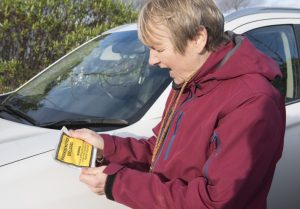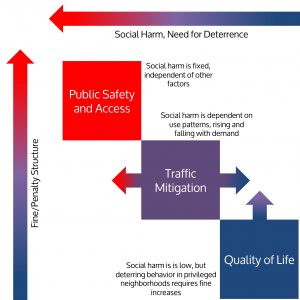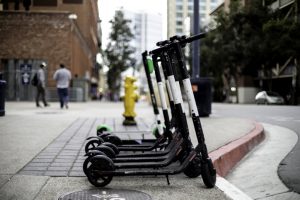 By Matt Darst and Michael Brown
By Matt Darst and Michael Brown
On a recent trip, I counted more than a dozen illegally parked vehicles traveling from my quarters to a coffee shop just two blocks away. Despite street sweeping bans in effect, a number of motorists decided to park illegally. I wondered why so many drivers would risk citations.
The average household income in this particular neighborhood is pretty high. Motorists likely reasoned that the risk of a citation was less than the opportunity cost of searching for legal parking someplace else.
Parking laws exist for a reason. Cities often establish fine values based on the specific social harm (affecting disabled people, exacerbating supply side problems, making it more difficult for others to park, etc.) a particular infraction creates and the need for deterrence. Generally, infractions fit in one of three categories:
- Level 1: Violations that promote public safety and access for persons with disabilities. The most egregious infractions typically carry the highest fines.
- Level 2: Citations that mitigate traffic. Less egregious, but important to mobility goals.
- Level 3: Infractions that affect the quality of life. These are citations designed to promote general order and beautification and they’re the cheapest fines.
Just as the resultant social harm varies across violation types, the damage caused by illegal parking can vary by date, time, and location. A person who fails to pay a parking meter at 7 a.m. on a Monday when the spaces are only 10 percent occupied does not create the same social harm as someone who does it at 7 p.m. on a Friday when there’s no available parking. Cities often try to address this by creating zones with varying fine schedules, but that strategy fails to recognize the dramatic shifts in curbside utilization throughout a day.
Similar to the concept of curbside demand management employed by Washington, D.C., maybe cities should tie level 1 fines to occupancy, reducing the fees when demand is low and increasing penalties when demand is high.
We wonder if people in disadvantaged neighborhoods are as likely to ignore street sweeping restrictions as people in wealthier areas. If fines have a greater deterrent value in underserved communities, maybe cities should consider linking residential penalties such as street sweeping to the economics/demographics of each neighborhood. A sliding scale for fines and penalties tailored to the true social harm created by various infractions could have several benefits, including reducing congestion, improving the quality of life in neighborhoods, and improving revenue by redistributing the greatest penalties to those who either cause the most harm to society or fail to be deterred from parking in contravention of posted restrictions.
 At the end of the day, all parking professionals strive to make the administration of the curb fairer. Rethinking fine structures could potentially deter illegal parking, reduce the comparative social harm, and help encourage social equity.
At the end of the day, all parking professionals strive to make the administration of the curb fairer. Rethinking fine structures could potentially deter illegal parking, reduce the comparative social harm, and help encourage social equity.
Matt Darst is senior director, parking and mobility, and Michael Brown is national director of collections, with Conduent.
 By Nathan Donnell, CAPP
By Nathan Donnell, CAPP
 Fleets of self-driving vehicles are about to become the norm. What does that mean for the parking and mobility industry? We’ll give you a hint: They’re driverless. Autonomous vehicles will change the fundamentals of the entire transportation landscape, and that includes fleets–and the way they interact with parking and mobility facilities and infrastructure.
Fleets of self-driving vehicles are about to become the norm. What does that mean for the parking and mobility industry? We’ll give you a hint: They’re driverless. Autonomous vehicles will change the fundamentals of the entire transportation landscape, and that includes fleets–and the way they interact with parking and mobility facilities and infrastructure. Editor’s Note: The IPMI Blog is re-posting some of our biggest hits from 2019 through the holidays. New posts will resume on January 2.
Editor’s Note: The IPMI Blog is re-posting some of our biggest hits from 2019 through the holidays. New posts will resume on January 2. By Matt Darst and Michael Brown
By Matt Darst and Michael Brown At the end of the day, all parking professionals strive to make the administration of the curb fairer. Rethinking fine structures could potentially deter illegal parking, reduce the comparative social harm, and help encourage social equity.
At the end of the day, all parking professionals strive to make the administration of the curb fairer. Rethinking fine structures could potentially deter illegal parking, reduce the comparative social harm, and help encourage social equity. By Nathan Donnell
By Nathan Donnell Autonomous vehicles (AVs) will reduce the demand for parking in cities. Or they might increase it, depending. Same for the need for driving lanes, which affect the availability of bike lanes and pedestrian pathways. They might make cities more–or less–walkable, too.
Autonomous vehicles (AVs) will reduce the demand for parking in cities. Or they might increase it, depending. Same for the need for driving lanes, which affect the availability of bike lanes and pedestrian pathways. They might make cities more–or less–walkable, too. Are cities quick to adopt new transportation technology (autonomous vehicles, for one) because of a fear of missing out or desire to make headlines for being first, without considering the long-term implications of what they’re doing? At least one analyst believes so, and he’s writing about it.
Are cities quick to adopt new transportation technology (autonomous vehicles, for one) because of a fear of missing out or desire to make headlines for being first, without considering the long-term implications of what they’re doing? At least one analyst believes so, and he’s writing about it. Ford Motor Company’s in-house futurist has started in-depth meetings with U.S. city leaders to try and forecast how shared, autonomous vehicles might affect daily life and what infrastructure, regulations, and other things need to be put into place before widespread adoption. A few highlights from a Washington Post story on the effort:
Ford Motor Company’s in-house futurist has started in-depth meetings with U.S. city leaders to try and forecast how shared, autonomous vehicles might affect daily life and what infrastructure, regulations, and other things need to be put into place before widespread adoption. A few highlights from a Washington Post story on the effort: By David Feehan
By David Feehan